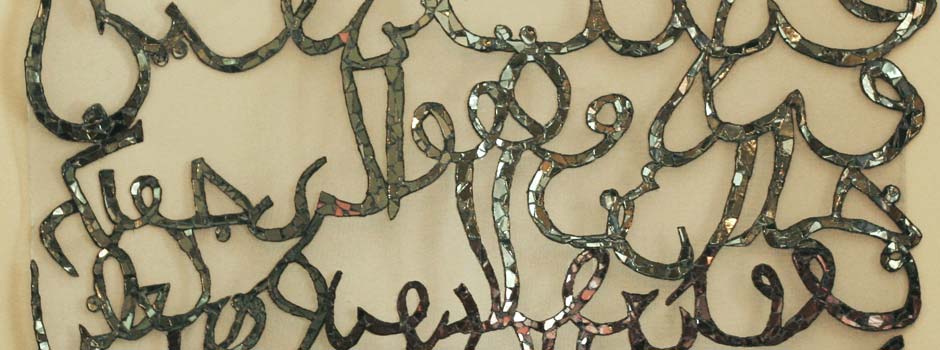
An Interview with Kashmiri-Canadian-American artist Hayat Gul Colour, Pattern, and Text in Abundance
Sep 08, 2012 Interview

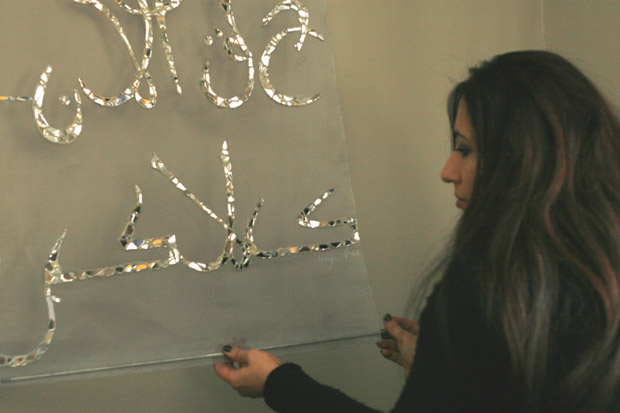 Hayat Gul in front of her work "Seek Knowledge", Al-Alaq, 36x60 in, 2009 / Courtesy of the Artist
Hayat Gul in front of her work "Seek Knowledge", Al-Alaq, 36x60 in, 2009 / Courtesy of the Artist
Yes, it does. I think it comes from not having any rules to follow. I am self-taught which is helpful to me as an artist. I just love making art. I use whatever medium I am attracted to and try and take it to its full capacity and exhaust all possibilities, which are of course endless. I never thought I would be showing as I am today with all these artists with art school credentials and again I am happy to be self-taught. The difference is that in dealing with issues of identity a lot of them are creating work that, for example, depicts their bodies as distorted, while in my own art digging into Islam uses beauty. Beauty is important for me too.
It’s really simple. In 2000 I dropped a mirror and glass art was born! The broken pieces on the floor looked like words. During this period, I felt connected to God and thought He was sending messages to me in different ways. So I thought, “Let’s make calligraphy in glass mosaicâ€. I started out with the names of Allah, the ones we learned as children to heal and protect ourselves. However, I was also searching into my past and rediscovering the faith that I’d been taught as a child. I wanted to push the concept and technique of glass mosaic to the limit. How far can I take this and what more can I achieve with glass and mirror?
At first, people considered the work decorative art or craft and bought them as gifts (they were much more affordable then) but suddenly things changed. The response to the art became really very positive and people wanted to exhibit it. And the interest continues today.
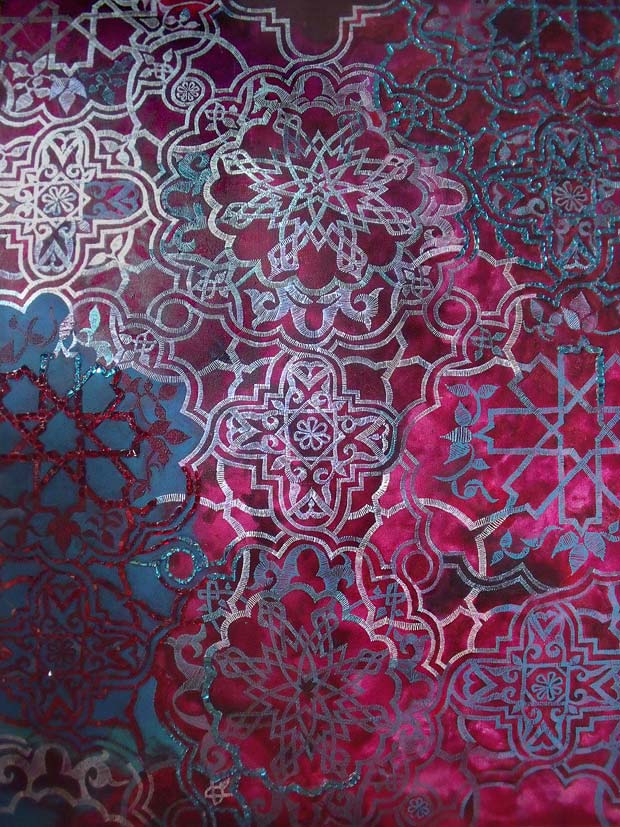 Hayat Gul / "Blue Red Fort", 36x48 in, 2011 / Courtesy of the Artist
Hayat Gul / "Blue Red Fort", 36x48 in, 2011 / Courtesy of the Artist
These were experimental pieces that were first exhibited in Italy. One shows verses from Surah Al ‘Alaq. This piece is about the fetus in the mother’s womb. I wanted to share with the public how the word itself “‘alaq†means blood clot, a leech-like thing (‘alaqa) hanging to something. This knowledge was only discovered in the West with the use of modern medical technology in the 1970’s and 1980s. To clarify, the embryo only has the leech-like appearance for a few days and is hardly visible to the human eye but was described clearly in the Qur’an revealed in the 7th century before being understood anywhere else only centuries later.
The medium is mirror on net. Each piece involves a multiple step process to complete. First, I make the calligraphy then I cut it out in paper. Each piece has to be cut out then stuck onto the net or mesh background with the same glue used by NASA. That is the difficult part. When it’s dry, you turn it around and start fixing the mosaic onto the paper. In Italy, there was a lot of interest for the technique. There the work was photographed by CNN and I ran out of statement cards since people were so intrigued by the aesthetic and wanted to know how the glass adhered to the net. I just wanted it to look like words floating on the wall. That was my intention. Part of the beauty of the art is that it is organic. These pieces will be showing in September at the Therese Malone Gallery in New Jersey as part of a show curated by Virginia Butera.
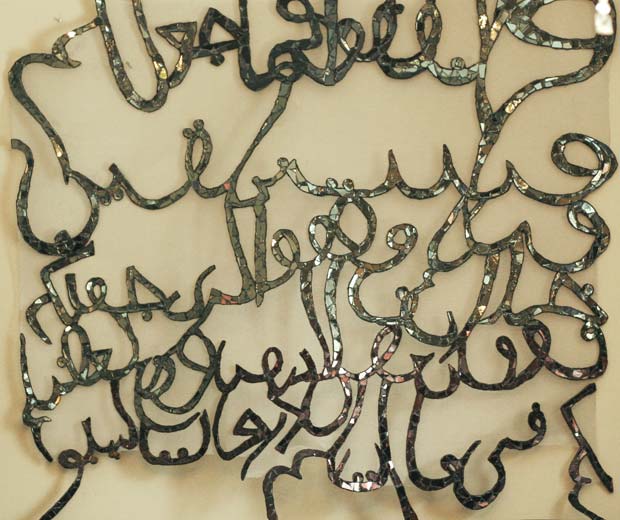 Hayat Gul / Seek Knowledge, Al-Anam, mirror on net, 54x54 in, 2009 / Courtesy of the Artist
Hayat Gul / Seek Knowledge, Al-Anam, mirror on net, 54x54 in, 2009 / Courtesy of the Artist
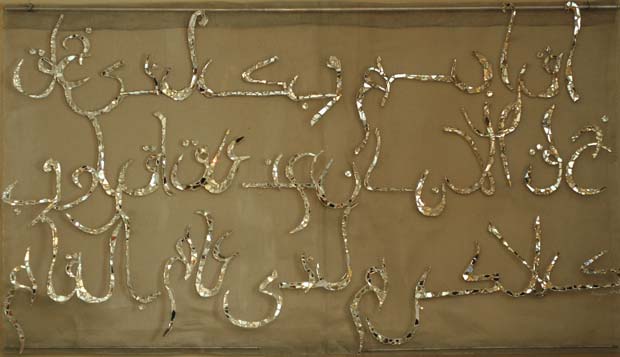 Hayat Gul / Seek Knowledge, Al-Alaq, mirror on net, 36x60 in, 2009 / Courtesy of the Artist
Hayat Gul / Seek Knowledge, Al-Alaq, mirror on net, 36x60 in, 2009 / Courtesy of the Artist
Definitely it is more intuitive. I never think about these issues consciously when I make the work. I am subconsciously attracted to ancient traditions and art, calligraphy being one of them. However, being an artist in the 21st century allows me to express my art with any medium that I choose. I am happy that script is married into a more modern art form. Calligraphy is a modern art form as it continues to inform the work of many contemporary artists. It is beautiful and limitless. What is inspiring is to take modern materials and to make calligraphy into something that has never been done before.
 Hayat Gul / Gold and Silver Fort, mixed-media-on-canvas, 2012 / Courtesy of the Artist
Hayat Gul / Gold and Silver Fort, mixed-media-on-canvas, 2012 / Courtesy of the Artist
This work too is being received very well. I started the series in 2010 after a residency in Jordan where I was working in a Palestinian refugee camp using art as a tool of healing for the kids. Looking at how the children work and looking at their situation uprooted from their homeland and traditions and living in a camp, I began to question myself: What is Islam? What are my roots? How will these kids now adapt without their homes, being uprooted? In Jordan as in many Muslim countries, I was surrounded by pattern and decided to work with this element in my art. In turn, the pattern led me to discover fractals which were invented by Muslim medieval mathematicians. I’m working with patterns taken from the Alhambra and, like in the calligraphic work, there is an educational component. I want to show how Islamic scholars in the 11th century and even before, were using fractal equations to create these patterns which are infinite and perfectly symmetrical. Many people believe fractals were only invented in Europe in the 1970s.
I presently have an installation at the Queen’s Art Museum which includes my glass technique combined with henna designs rendered with acrylics right onto the wall. The show is up until October 4th. As it has just opened, I have yet to know the response. I am exhibiting with some very established artists such as Jaishri Abichandani, Chitra Ganesh, Ruby Chisti, Samira Abbassy,and some other very strong artists. I do know that the show was reviewed by Holland Cotter in the NY Times which is great.
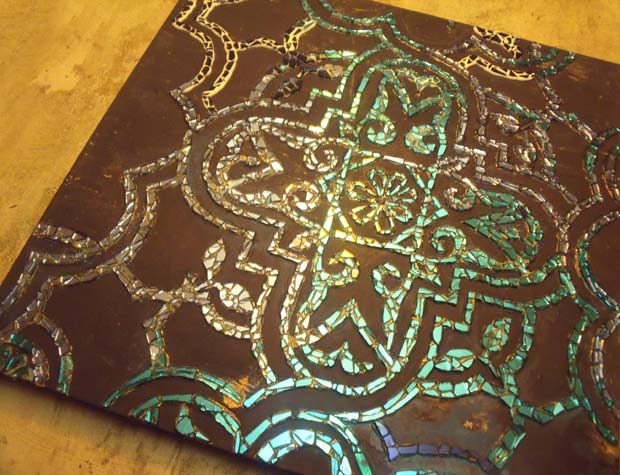 Hayat Gul / One part of "Blue Fort", 24x24 in, 2012 / Courtesy of the Artist
Hayat Gul / One part of "Blue Fort", 24x24 in, 2012 / Courtesy of the Artist
Well, what is serious art? In order to produce each piece I take one part of a pattern I’ve chosen and recreate it. I then enlarge it and trace it onto canvas. In one group, some pieces are 24 inches by 24 inches and they can be shown alone or as many as the patterns connect. This work is my way of “importing†the Alhambra, which is a magnificent example of symmetrical fractal art and letting others be a part of it.
I see the material as part of a meditative process, cutting and breaking the glass and then reforming the tiny pieces into deliberately complex patterns. It simply is truly that- meditative and I am trying to see how many more possibilities there are with glass and mirror as medium. In the Presence of Geometry series, each piece becomes more than just a painting. It takes on its own life, it’s a cross between painting and sculpture. It adds texture. I’m very attracted to textures in general and like many artists, I like to bring together different materials. The glass technique is also my own invention. In terms of light, the work looks most beautiful in natural light.
 Hayat Gul / "Blue Fort", 24x24 in, 2012 / Courtesy of the Artist
Hayat Gul / "Blue Fort", 24x24 in, 2012 / Courtesy of the Artist
I am never aware of what male or female art is. Some men practice henna. In fact, the master henna artist I studied with was a man. I don’t make a distinction between henna and glass. Henna is a beautiful ancient healing art that I started practicing and that just kind of blossomed into a business as well as a teaching art and form of adornment that uses the body as canvas.. I strongly feel that we are now entering a more conscious century where people are turning to natural healing to deal with stress. Henna has been used for many medicinal purposes for over 9000 years old. When I started practising, many of my clients kept saying the treatment made them feel calm. I started attaching healing power to the work and I started to research the substance that releases anxiety and cools the body temperature. These are facts. I’ve had a tremendous response to henna art from all my clients. One family was so happy with my work that they flew me to Costa Rica as a henna artist for their wedding. I was a bit nervous as I wasn’t sure how the designs would turn out in the middle of the rainforest.
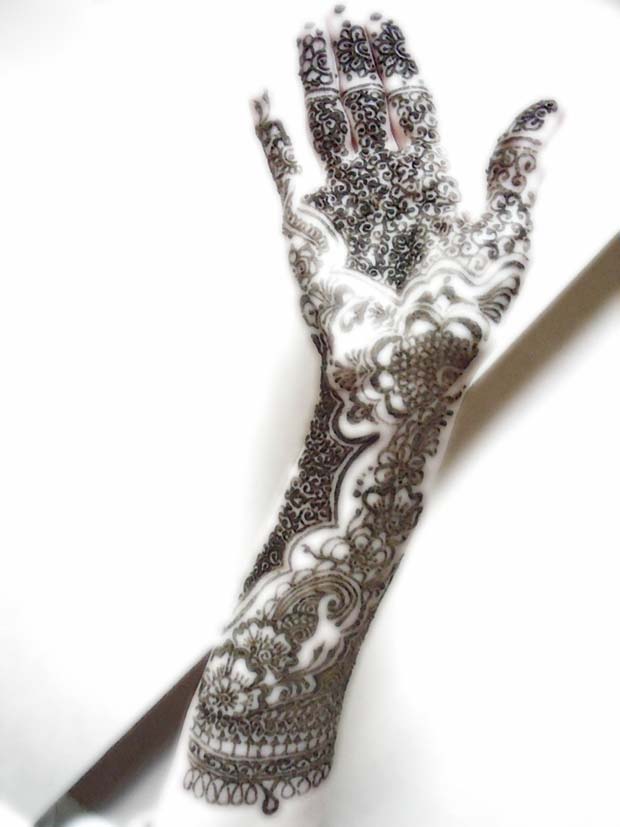 Hayat Gul / Bridal crop / Courtesy of the Artist
Hayat Gul / Bridal crop / Courtesy of the Artist
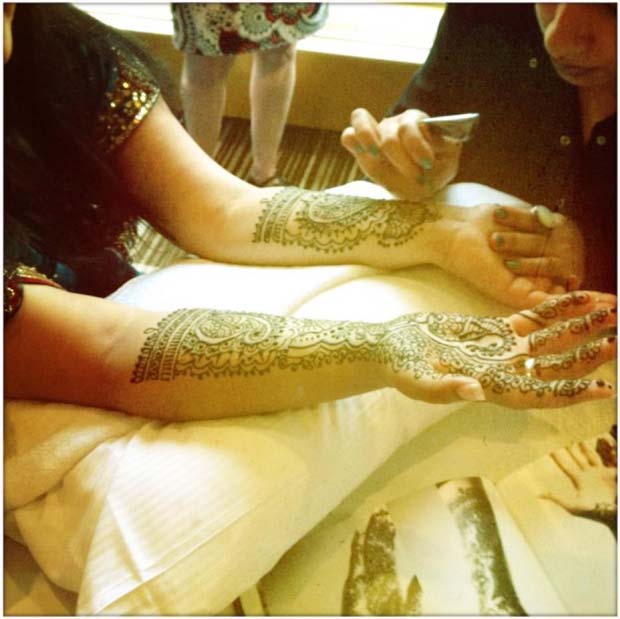 Hayat Gul / Bridal crop / Courtesy of the Artist
Hayat Gul / Bridal crop / Courtesy of the Artist
Sort of, I have a really simple answer for this. I create the art subconsciously and it is often perceived as beautiful. Beauty is created by Allah to heal us and if we allow it, it soothes us. If I see something beautiful, I feel happy.
My immediate focus is on the work itself. I want to work on the Presence of Geometry series as I have many more ideas. So far, I have been using canvas but I want to work with the same concepts in other media as well. In terms of my career, I never plan but I know things will come up as they always do. I am presently working on a new catalogue of my art to make it more visible. I am also hoping to get one of my new pieces into the new Park 51 community center as part of its permanent collection.
Thank you.
Comments
Add a comment